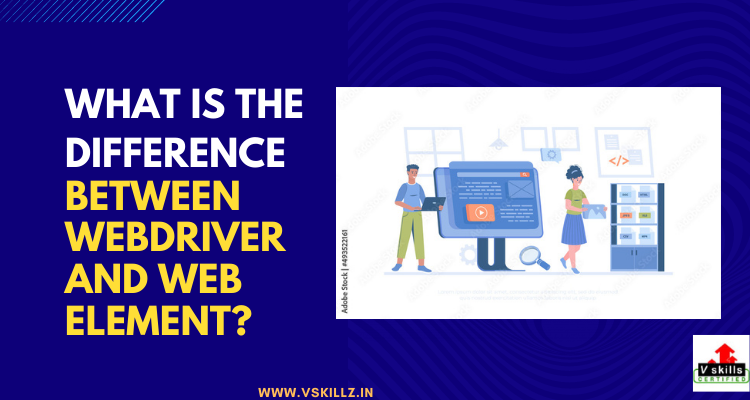Webdriver and Web element in Selenium, are the essential concept which may seem similar but are very different. In this article, we will illustrate the what is Webdriver and Web element in Selenium as well as differences between the both. Software testing professionals should be aware of Webdriver and Web element in Selenium automation testing tool.
What is Webdriver in Selenium
Web driver is an Interface which contains all the abstract methods. Remote WebDriver class implements Web Driver interface which is extended by browser drivers.
In recent times multiple browsers to be had inside the marketplace like Chrome, Firefox, Opera, Safari, and so forth. And each browser has its very own manner to implements matters just like the lunching browser, near browser decrease browser and so on.
It’s not possible for selenium developers to develop separate frameworks for each browser. And browser group additionally no longer allow changing their supply code according to selenium requirement.
So they devise an agent this is called browser instructions Like Chrome driver, Firefox driving force. Those driving force training work as an interface among selenium and browsers or you can say its conversation medium between selenium and browsers.
Selenium builders do not understand the common sense and common sense of the entire browser so they created WebDriver as an interface. Which comprise all the abstract techniques without common sense and implementation and gave to browsers to deal with them whenever those strategies are called on browsers.
Remote WebDriver elegance implements Web Driver interface that’s prolonged through browser driver’s magnificence.
So now if I want to apply carry out the operation with chrome browser I need to create an item of Chrome driver.
What is Web element in selenium
Web Element: In simple words, Web Element is a representation of HTML elements. HTML elements are the tag which is starts and ends with some tag. For example heading tag: <h1>Contain…. </h1> here h1 is tag or we can say HTML elements. An HTML element can contain multiple elements that are called nested elements.
To handle these elements selenium provides Web Element Interface. There are lots of useful methods in the web element interface to interact with these HTML elements and for performing operations. The Followings are a few critical strategies that are commonly used.
Click on (): void
This approach is used for simplest click on the factors it will no longer go back something. For example, we’ve got a button element and we simply want to click on that button.
Web Element button = driver.findElement (by using. Path (“//*[@id=”btn_basic_example”]”));
Button. Click on ();
Clean ():void
This technique uses to clear any enter field and it’s going to not return any value. For instance, we need to clear text from any input container.
Web Element enter = driver.findElement (via. Path (“//*[@id=”user-message”]”));
Enter. Clean ();
Send Keys (Char Sequence… keysToSend): void
This approach makes use of to set a textual content value to an input box and it takes a string a parameter. For example, if we need to ship any textual content in an input box.
Web Element input = motive force.findElement (by using. Path (“//*[@id=”user-message”]”));
input.sendKeys (“hey oldsters”);
Get Text (): String
This method will go back a textual content of the detail. As an example: Take the textual content of the heading.
Web Element enter = motive force.findElement(with the aid of. Path(“//*[@id=”easycont”]/div/div[2]/h3″));
String headingText = input.getText();
isEnabled():boolean
This approach used to confirm the element is enabled or disable as an instance we need to check a button is enable or disable.
WebElement button = driving force.findElement(by using.xpath(“//*[@id=”btn_basic_example”]”));
button.isEnabled();
isDisplayed():boolean
This technique is used to confirm the detail is displayed or now not.
As an instance:
Web Element button = driving force.findElement (through. Path (“//*[@id=”btn_basic_example”]”));
button.isDisplayed ();
Is Selected():Boolean
This method is used to verify an element is choosing or not. It’s miles widely used in checkboxes, radio bins, and alternatives in pick out.
Some of the variations between Web Element and Web Driver interfaces in Selenium are:
Each put in force Search Context interface. For that reason, both of them outline the Fundament () and Find Elements () techniques. The difference is Web Element’s find Element(s) search for factors within the Web Element. That is, they seek most effective for infant factors of the unique element inside the browser but Web Driver’s find Element(s) techniques seek full browser. So, the scope of trying to find factors differs in both instances.
Web Element refers to an HTML element. Accordingly, All Interactions at the HTML elements e.g. click on, send keys, select etc. are achieved the use of Web Element. Web Driver represents the browser consequently, all interactions like controlling the browser of finding web elements at the page is executed with the aid of Web Driver.
a number of the ordinarily used Web Elements methods are: click(), get Size(), get Text(), get Tag Name(), is Enabled(), is Selected(), put up() etc. a number of the in general used Web Driver techniques are near(), getCurrentUrl(), get Title(), getWindowHandle(), manage(), navigate(),quit(), switch To() and many others.
Conclusion
The main difference is how you write your tests. Selenium-web driver is a mix of promises and callbacks – Web driverIO only works with promises and can be used as standalone or with an internal test runner. There is also a library called wd.js.



